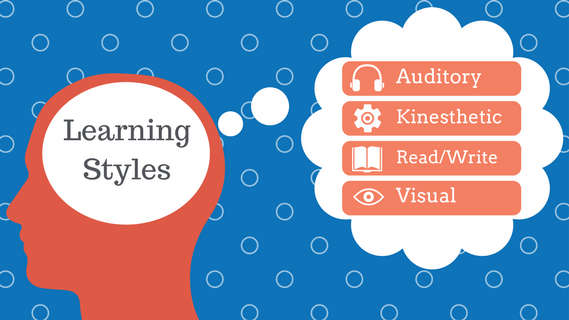Trinity In Twelve Weeks
- Online Resources
- Time Management
- Note-Taking
- Writing
- Procrastination
You can also find out more about all of these topics (as well as details about upcoming workshops and making one-to-one appointments) from Student Learning Development!
Student Blogs
Sophister students share their thoughts on each week's theme and topics.
Alison Zobenko - Biological and Biomedical Sciences
Hello! My name is Alison and I study Biological and Biomedical Sciences, majoring in Zoology! Over my 4 years in College I have found myself going through so many phases in my study techniques. I would not say I have perfected it, but I will share what has worked for myself and my friends.
One tip I would like to give before you read anything else is to actually use your @TCD.ie email for studying applications - you would be surprised at the benefits. Notion premium is free for Trinity emails and there may be other applications that are similar that I don’t even know about.
As I said, we all seem to go through study technique phases within 1st year where we discover one application and just stick to it (I may be pointing at you, OneNote), but over time I have found that experimenting with different applications and thinking about what you require for optimal studying is best! For example, if you learn best from flashcards, transferring all of your information from Google Docs/OneNote to Quizlet is extremely time consuming during exam season. Hence, finding an application that can do both at once would be more beneficial, such as RemNote, where you can write notes and turn them into flashcards as you type in your lectures.
Poor time management and procrastination are the easiest and most devious pitfalls you can fall into during any season in the semester - especially when you have many extra-curricular activities and responsibilities. I love being a busy-bee, but unfortunately you also need to be an academic weapon, as that is what you pay for... so I like to devote ‘office hours’ to myself. I find that when I have weird breaks in between classes it takes me a while to get into the study groove and I don’t benefit much from it, so I don’t force myself to study then. Instead, I eat lunch or do any quick tasks (such as making a quick Canva post) since that is easier for me given the time constraint. I recommend devoting at least one full weekend day (or weekday if you have that off) along with some bigger gaps in your schedule - since I like ticking off my entire checklist in one day - to College work/study tasks. Personally, doing assignments day by day seems neverending and draining. Call it Pavlov’s dog - when you see that time and day come around, you start opening up your laptop. But, don’t worry, I don’t work like a dog - on the day of, I go to the gym, study, and - if I don’t have too much to do - I go out with friends or finish any crafts that have been waiting for me!
Here is my go-to guide for you to look through and get you thinking about your current ways of organisation and studying ~
Note Taking
- OneNote - Great for combining hand drawn notes + typed writing
- Google Docs - Format is a bit restricting for me personally
- Goodnotes - For iPad users. You can write on top of PowerPoint slides and make your own notes also!
- RemNote - Good for quiz cards as well as note-taking
Organisation
- Google calendar - Great for those who like to schedule their entire day by the hour by colour blocking their assignments, classes, due dates and personal times.
- Notion - If you get motivated by cute decor then it is definitely an all-in-one app where you can take notes, have a calendar, and access many other organisational perks. Keep looking through YouTube tutorials where they always link their templates so that you don’t have to build everything from scratch. (Notion takes too long to load up on my laptop so unfortunately I had to give it up for daily use :-( so I now just use it to organise trips).
- Evernote - This app is like if Notion and OneNote had a baby, so if you like the benefits of both then I would recommend checking it out!
- Notes App - A good old list on a notes app of the things I need to do for that day is actually what works best for me despite its simplicity. I input my major deadlines into my phone calendar and what I have to accomplish by the end of the day and also the week. Although, this is not for forgetful people since my mind is filled with my tasks until I clear them off, so be warned!
Online Resources
Academic Skills for Successful Learning Module
Why Take the Module?
This Module has been specially designed by our Student Learning Development (SLD) team to help Trinity students reach their academic potential. SLD work with students who are struggling with their studies, as well as high-achieving students who want to further improve their performance.
Coming to College can be a challenging experience. Some of the skills you need are different to those you used in second level education, and may be different to skills you developed in other universities, your work, or your home life. Through this Blackboard Module, we want to help you learn these new skills, and we have designed it so that can explore the content in your own time and at your own pace.
Anyone can sign up to the Academic Skills for Successful Learning Module by searching for it in Blackboard: 'ACADEMIC SKILLS FOR SUCCESSFUL LEARNING.'
Module Structure
The Module covers all of the important skills you'll need for successful Study, including (but not limited to!):
- Note-taking Skills
- Reading Skills
- Critical Thinking Skills
- Writing Skills
- Time Management Skills
- Exam Skills
Each section of the Module will introduce you to different ways in which you will be learning, communicating, studying, and preparing for assessments over the coming months. You can work your way through all of the sections, or pick and choose specific areas in which you would like to improve your skills.
This Module is designed for 'self-study,' and its content and resources are available for you to use at any time.
How to Self-Enrol in the Online Module
Students can self-enrol in the Academic Skills for Successful Learning module on Blackboard. The process (detailed below) only takes a couple of minutes!
- Visit Blackboard (mymodule.tcd.ie).
- Log in using your College network username and password.
- Click into the 'Modules' tab in the left-hand menu.
- Click into the 'Module Catalogue' in the top-right corner of the screen. (The Module Catalogue icon looks like a little set of books).
- In the Module Search Box enter 'academic skills' (if searching by Name), or 'ASSL' (if searching by Course ID).
- Only one result should appear: Course ID 'ASSL-SLD.' Click the pop-down arrow next to the Course ID, and select 'Enrol.'
- Click 'Submit' to proceed.
- Click 'OK.'
- You should now be redirected to the Module's homepage. However, you may need to log out (and then back in!) to Blackboard if you cannot see all of the Module's content after self-enrolling.
- You should now be able to access the Module under the heading 'Others' at the bottom of your Modules page in Blackboard.
Access The Academic Skills Module
Healthy Trinity Online Tool
Academic life can be brilliant because it's all about learning. We learn a lot about subjects in classes obviously, but coming to Trinity also means learning a lot more about yourself, other people, and the part you play in your community and the world. Whether you have just finished school, or you’re here as a mature student, whether you travel to Trinity from just down the street, have moved to Dublin for the first time, or you’re an international student and you’re here from overseas, there’s lots to learn about this new type of life.
In the Healthy Trinity Online Tool (H-TOT), we have gathered lots of resources for you to support you in managing your academic life in a healthy way, and to help other students, too. This includes information about studying, how to get in touch with your Tutor, and how to embrace changing relationships with friends and family.
To access academic and learning resources in the Healthy Trinity Online Tool, use Chrome to log in to Blackboard. Use the Assist tool on the left to find the ‘Healthy Trinity Online Tool,’ then click on the 'Academic Life' section on the homepage.
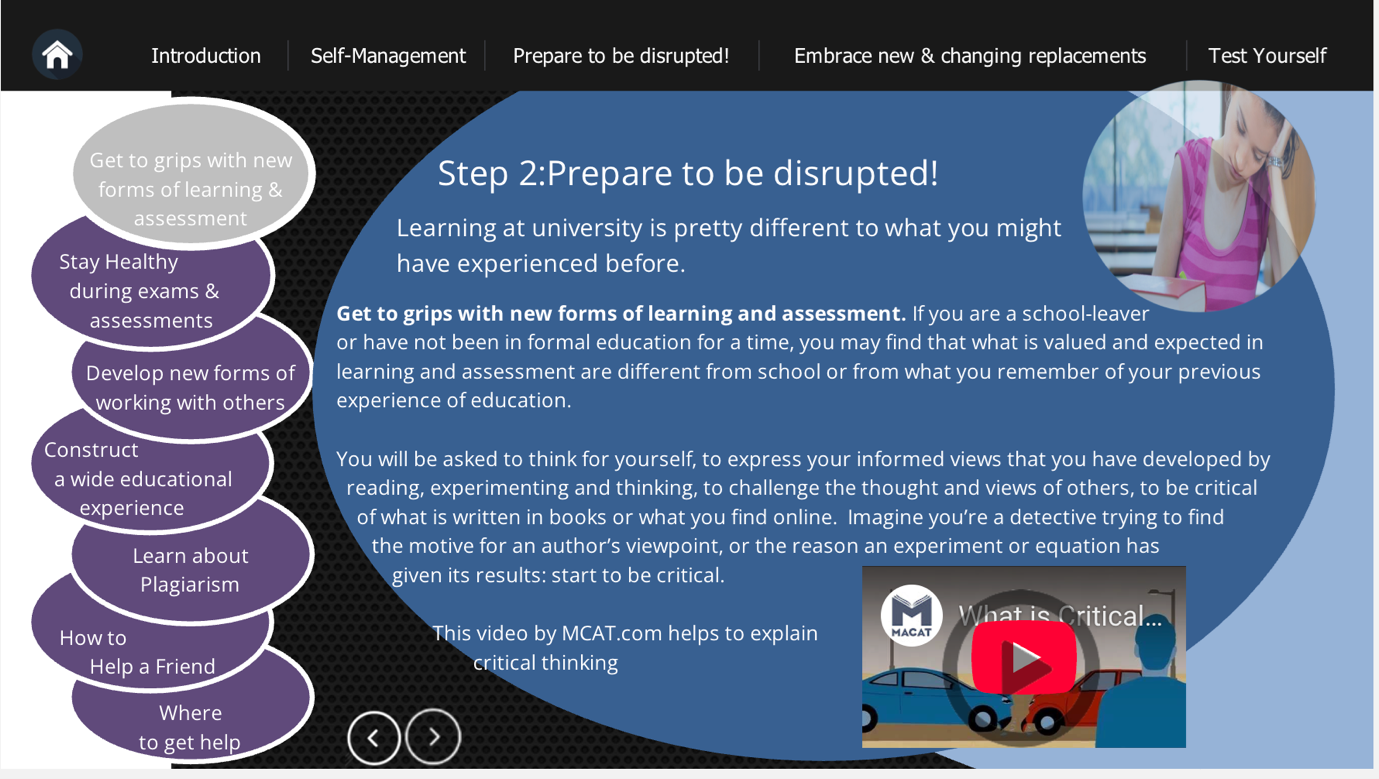
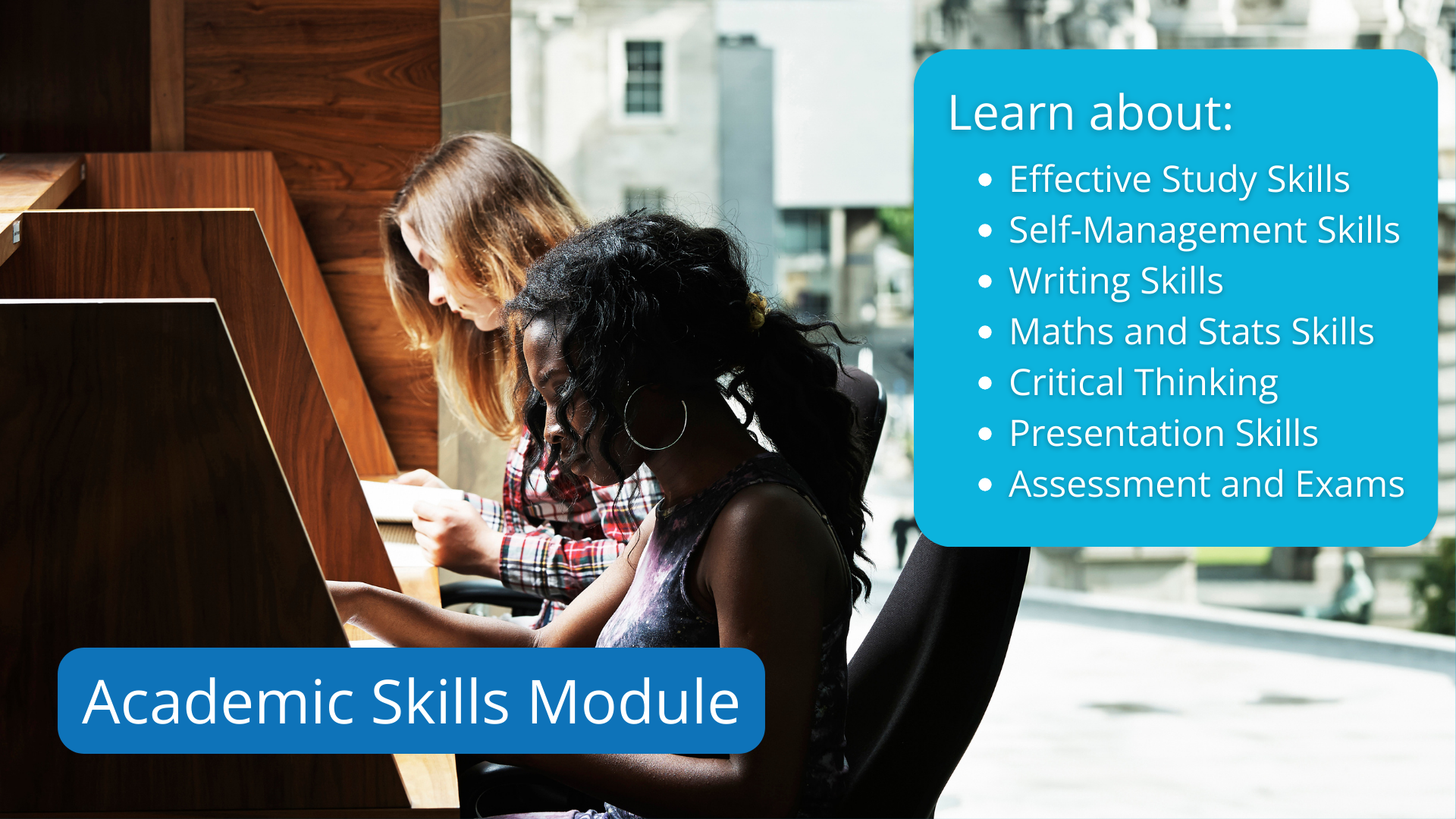
Time Management
Time Management Strategies
Check out the time management strategies from SLD below, then find out more through the Academic Skills for Successful Learning Blackboard Module!
- Prioritise: You probably have a lot of things to do, so assess how important and how urgent the tasks are, then make sure high priority tasks get done first and are not put off on a regular basis. Make sure to avoid time-wasting busy-work!
- Be specific: Make the task as specific as possible - we tend to follow through then, especially if we write it down. For example, instead of telling yourself 'I’ll do some statistics this week,' try 'I’ll work through 3 descriptive statistics problems on Tuesday at 7pm.'
- Small bite-size pieces: It’s easy to feel overwhelmed, so try breaking tasks down into smaller sub-tasks. Once you’ve started working on something, it’s easier to keep going.
- Use all available time: This is an especially good strategy if you are pressed for time. You don’t necessarily need a block of time in order to study. Students often have pockets of time between classes, when travelling to College, etc. There are lots of study tasks that can be accomplished in short periods, such as reviewing the main points of a reading or lecture.
- Structure the environment: Find a place to study - preferably one you can use regularly and with limited distractions. Make sure you have all the essentials that you need to study there so that you have no excuses not to work.
- Establish a routine: We are creatures of habit. If you always study at a certain time or on a particular day, then it will be easier to get into concentration mode. Also, it is better to study briefly and regularly than to work for hours on end once every couple of weeks.
Academic Skills Blackboard Module
Organising Your Materials
It's easier to manage your time when your materials are organised, as you won't have to waste time figuring out where you put your notes on 'x' subject or your lucky pen each time you want to get some work done.
Here are some top tips to help you get organised and stay organised long-term:
- Set up different folders for different modules on your computer rather than having lots of individual documents cluttering up the space. Back up your files and folders using drive, online, or external offline storage.
- Label files, folders (including digital ones!), boxes, notebooks, etc. accurately. If possible, use colour coding and assign a different colour to each module or subject to make it easier for you to tell your materials apart. You may also find it helpful to use pictures.
- File your lecture notes, handouts, etc. in the correct place as soon as you get home each day. If taking notes electronically, take twenty seconds at the end of each class to make sure you know how and where you're saving your files!
- Once a week, sort any remaining loose papers and handouts, draft documents, etc. into the relevant files and folders.
- Display important information on a whiteboard or pinboard near your desk or computer.
- Use a wall planner in addition to a diary, or enter all of your commitments, diary items, and timetable into a digital calendar such as the Google Calendar included in your MyZone account.
You'll find more resources to improve your organisational skills in the Academic Skills for Successful Learning Blackboard Module!
Academic Skills Blackboard Module
Planning
You will often find that you have multiple deadlines for different modules at the end of semesters, or around Reading Weeks. It is important to plan your time in order to stay on top of your workload... Luckily, SLD have some strategies to help you do this!
- Create a master schedule that indicates on a semester or yearly basis when holidays, exams, presentations, essays, etc. are or will be due. Post it in a prominent spot!
- Create a weekly schedule...
- At a regular time - e.g. Sunday evenings at 6pm - plan your week ahead, taking into account your master schedule, any recent developments, and your study goals for that week.
- Mark out your known commitments such as classes, labs, work, sport, meals, etc.
- Make a list of your study tasks - be specific and prioritise.
- Schedule these study tasks into available time slots, taking the purpose of the task into consideration. For example, if you are working on an essay, more time will be needed, and so schedule yourself an hour or two, rather than 15 minutes. If the purpose is review, say to scan a text, then make use of the odd half hours you have available.
- Schedule tasks that may require maximum concentration during your daily “peaks” or periods of maximum alertness – these will vary from person to person.
- Allot times for relaxation, exercise, etc., and be sure to include a 'cease study' time that gives you time to unwind before you sleep (and it gives you something to look forward to at the end of the day!).
- Monitor and evaluate your schedule. Review what you have accomplished at the end of a day, and decide if the schedule for the next day needs to be changed as a result.
- Some students work better using a detailed daily 'to-do' list. Again, at a regular time (for example, last thing at night or first thing in the morning), plan out your day, taking into account your master schedule and study goals for the week.
- When you have finished a study task, cross it off your timetable or list.
- Avoid too much detail - a schedule has to remain flexible or it becomes a dinosaur! Everyone has different needs; perhaps start with just organising study tasks for certain classes, or by only listing your priorities.
- Schedule in rewards - for example, time watching your favourite TV programme after doing a task you were dreading.
You'll find a downloadable to-do list template, as well as weekly, monthly, and annual planners in the Academic Skills for Successful Learning Blackboard Module.
Note-Taking
Note-Taking Methods
There are many ways of taking notes, each with various advantages and disadvantages. Some of the most commonly-used examples include:
- Prose or linear - Many students use this note-taking method (basically written paragraphs) and are familiar with it. While this type of note-taking can provide useful summaries of information, the disadvantages are that it encourages verbatim copying and doesn't allow for organisational strategy use.

- Outline - The advantage of this note-taking method is that it is more visual and allows for the imposition of structure. It forces the note-taker to create main points. A disadvantage is that sometimes material is not conducive or provided in a format that lends itself to outlining.
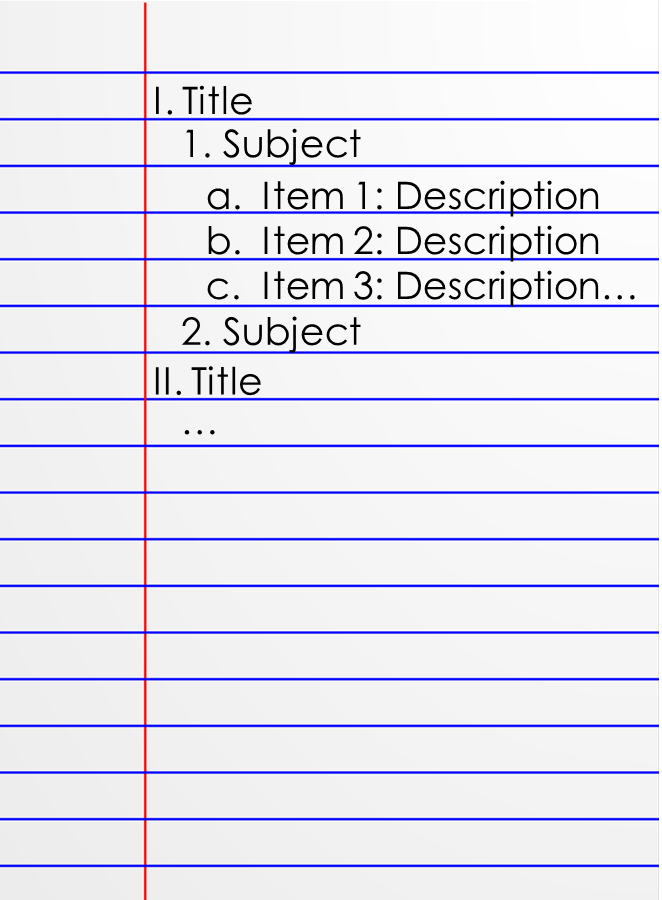
- Mind maps or patterened [Buzan] - Sometimes referred to as spider diagrams, the notes start in the middle of a page and 'explode' out towards the edges. The advantage of this note-taking method is that it is very visual, allows for structure, and displays relationships. Such notes are very useful for review and recall, brainstorming, and revision purposes. Also, they work on both a verbal and a non-verbal level. Another advantage is that a lot of information can be condensed into a small area. Disadvantages include that they are hard to produce - especially from lectures - and that they require practice.

- Cornell or split-page - This method involves drawing a line down the page, about 1/3 away from the left-hand edge. The larger right-hand side is used to record notes. The left-hand side is reserved for key words and main points. These can be completed after the lecture, when trying to condense the information. Adding a summary section at the bottom of your notes will also help with this. The advantage of the Cornell/split-page method is that it forces the note-taker to select main points. It also provides a basis for self-examination (by covering over the right-hand side and quizzing yourself using the points on the left-hand side). However, it needs practice.
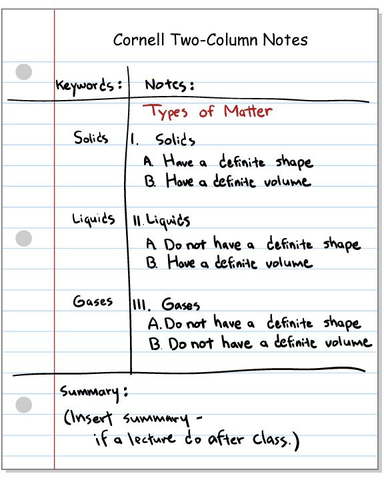
Taking Notes in Lectures
Attending lectures offers you the best chance to learn about material that may not be covered in the textbook, to become aware of links between topics, and (possibly) to discover what may be on the exams.
Taking good notes from lectures involves being an active listener. Some hints for improving your lecture notes are:
- Sit in an appropriate spot to avoid distractions
- Focus on the content, not the speaker
- Review previous notes ahead of class for better continuity and comprehension
- Note examples and information provided on the board/overhead if you will not have access to this after class
- Listen for key words: because, two reasons, however, etc.
- Pay attention to non-verbal cues (eg. information that is repeated, the amount of time spent on a topic, any changes in the lecturer's tone) to identify particularly useful information
Another useful idea is to discuss the content covered in lectures as soon as possible after class to consolidate the information. For example, when leaving lecture halls, take a moment or two to go over main points or questions with your classmates; or, possibly go up to the lecturer at the end of class if there's something you're struggling to understand.
Taking Notes While Reading
When taking notes from books, it is a good idea to use summarising strategies to differentiate between arguments, main points, and evidence or details. It is all too easy to fall into a habit of copying large chunks of a text word-for-word - essentially producing a second edition of the material, rather than a meaningful set of notes which you can use effectively.
Next time you're reading a text, try out this strategy for summarising material:
- Skim the text and gain the general impression of the information, its content, and its relevance to your work; underline/highlight the main points as you read.
- Re-read the text, making notes of the main points.
- Cover the text and rewrite your notes in your own words.
- Begin your summary.
- Restate the main idea at the beginning of your summary, indicating where your information is from. Mention other major points, and change the order of the points if necessary to make the construction more logical.
- Re-read the work to check that you have included all of the important information clearly.
You should also check out the Library's guides and tutorials on how to find, evaluate, and apply information, as well as recordings of their study skills classes.
It is wise to keep track of exactly where you're noting information from in case you want to refer to the material in any submitted work; when quoting a source you'll typically be asked to reference the exact page(s) of a text from which you took the information. This may be a good time to review your Department's preferred referencing system and the College policy on academic integrity. We have also included some brief information and further resources on referencing below.
Writing
Referencing
The purpose of citing references is to enable a reader of your essay or paper to look up additional material informing or related to the information you provided. References are also an important way of acknowledging ideas, information, and quotations that are not your own. By not acknowledging others' work, you may seem to be presenting it as your own, and thereby committing plagiarism. For a refresher on plagiarism and academic integrity, go back to Week 1!
The task of writing will become a lot easier if you record the complete publication details of sources during your note-taking and research periods, as it will make referencing much more efficient. Just, please do make sure to file your notes and source records so that you can access them quickly and reliably!
The information you need to gather about a source might include its:
- Author
- Year of publication
- City of publication
- Publisher
- Page numbers
- URL
- The date you accessed the material
Here is an example of citing a reference in a piece of written work using elements of the information gathered about a source:
Referring to an item in your text is known as citing. You then need a list of references at the end of your work to indicate where the citation can be found. (Drew & Bingham, 1997, p.47)
The full reference would then be listed in a bibliography (sometimes called a reference list, and ordered alphabetically) at the end of the assignment as follows:
Drew, S. and Bingham, R. (1997) The Student Skills Guide. Aldershot: Gower Publishing Ltd.
The method used above is known as the Harvard style of citing references. Do check what style of referencing your School/Department uses prior to starting to write your assignments, as some prefer footnotes or endnotes rather than citations in the text. It is always best to check ahead of time to save yourself potentially having to redo work!
Schools and Departments may also provide guidelines on punctuation and other aspects of written work. You should be able to find all of this out via their webpages and/or your Course Handbook, and please ask your lecturers if you have any questions.
Essay Writing Strategy
When asked to write an essay, it may be useful to break the process down into smaller tasks to keep you on track. We recommend adopting a strategy like the below:
- Schedule your tasks, working backwards from the date of submission. Remember - things usually take a little bit longer than we expect!
- Make sure you understand the question your essay will be addressing.
- Do initial research on the subject.
- Create an outline based on your own understanding of your essay topic and initial research findings.
- Do further research. (Remember to look for sources which support and counter your own arguments/hypotheses.)
- Review your research findings and adapt your outline as required.
- Write your first draft (make sure to turn on autosave!).
- Revise your draft.
- Proofread your 'final' draft.
- Submit! ...and, once you have received your marked essay...
- Take time to review feedback!
Scientific Report Writing
This video, produced by the University of Hull, offers excellent advice on how to approach scientific report writing:
Procrastination
What Is It?
Procrastination is when we delay or put off something we know we have to do or that will ultimately benefit us. Most people practice procrastination in some form; maybe you clean your room when you're supposed to be studying, or maybe you watched 8 seasons of a TV show last week in a state of panicky guilt over an impending assignment. What is important is to know when it is time to stop making excuses and do something.
How to Combat It
The key to combating procrastination is to stop making excuses and do something. Here are a few different methods you can try to combat procrastination when you catch yourself putting something off:
- Take Action: Sometimes just doing something creates the mood and momentum to continue, so decide to do something - anything - to get you working!
- Salami Technique - Slice a task or goal down by function and time, getting down to its smallest unit. This is useful if your excuse for putting a task off is that it's so big or you have so much to do that you feel like you can't start. For example, a long reading assignment on a difficult subject can seem intimidating and easy to put off, so divide it into parts.
- Five Minutes - Spend 5 minutes on a task and see what progress you make.
- Related Tasks - Do something related to the task you don't want to do - the back door approach. For example, if you have to start a project that's intimidating, maybe decide to just go and talk to someone about it, and this in turn may lead you to the Library because they suggest a source you should use or they're going anyway. Often it can be easier to talk to someone about something you find stressful than having to sit with it alone.
- Worst First - That particularly boring or difficult task is often the easiest to put off - in fact you'll do anything not to get it done. But, it's normally better to get it out of the way. Mark Twain said something to the effect of: 'It's best to eat a live frog first thing in the morning, that way nothing worse can happen all day.'
- Make Commitments - An excuse that is often used to put off a task is 'I work better under pressure,' so create pressure. Tell people you plan to get something done, and then they'll ask if you got it done.
Procrastination Exercise
You might find this exercise useful in helping you combat procrastination:
Think about one problem that might develop (or has already developed) for you that might lead to procrastination...
- Describe the problem. Ask yourself:
- What is the source of the problem?
- What is the reason for the problem?
- Can you set a goal for a solution? (Be specific!)
- With your goal in mind, what options do you have? (Be practical in deciding your options).
- What are the advantages of each of your options?
- What are the disadvantages of each of your options?


